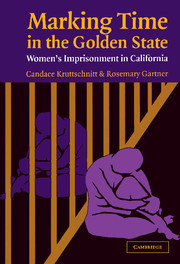Book contents
- Frontmatter
- Contents
- List of Figures and Tables
- Acknowledgments
- Marking Time in the Golden State
- 1 Introduction
- 2 Women, Crime, and Punishment in California
- 3 Entering the Prisons: Methods
- 4 Women's Experiences of Imprisonment at the California Institution for Women in the 1960s and the 1990s
- 5 Variations across Time and Place in Women's Prison Experiences
- 6 Negotiating Prison Life: How Women “Did Time” in the Punitive Era of the 1990s
- 7 Conclusion: The Spectrum of Women Prisoners' Experiences
- Appendix: Characteristics of Interviewees
- References
- Author Index
- Subject Index
5 - Variations across Time and Place in Women's Prison Experiences
Published online by Cambridge University Press: 15 December 2009
- Frontmatter
- Contents
- List of Figures and Tables
- Acknowledgments
- Marking Time in the Golden State
- 1 Introduction
- 2 Women, Crime, and Punishment in California
- 3 Entering the Prisons: Methods
- 4 Women's Experiences of Imprisonment at the California Institution for Women in the 1960s and the 1990s
- 5 Variations across Time and Place in Women's Prison Experiences
- 6 Negotiating Prison Life: How Women “Did Time” in the Punitive Era of the 1990s
- 7 Conclusion: The Spectrum of Women Prisoners' Experiences
- Appendix: Characteristics of Interviewees
- References
- Author Index
- Subject Index
Summary
a profile of each of california's thirty-three state prisons is provided on the California Department of Corrections (CDC) website, and each profile includes a brief “Institution Mission Summary.” The mission summary for the California Institution for Women (CIW) reads as follows:
CIW accommodates all custody levels of female inmates and functions as a reception/processing center for incoming female inmates. In addition to its large general population, CIW houses inmates with special needs such as pregnancy, psychiatric care, methadone, and medical problems such as HIV-infection.
The “Special Historical Note” that follows this summary and concludes CIW's profile highlights the prison's link to an earlier, more explicitly gendered penological era:
Until 1987, CIW was California's only prison for female felons. It was originally called “Frontera,” a feminine derivative of the word frontier – a new beginning. The campus-like design was in keeping with the 1950s “progressive” notion of rehabilitation.
The “Institution Mission Summary” for Valley State Prison for Women (VSPW), in contrast, is readily interpretable as representing a very different penological era, an era in which “system management, resource allocation, cost-benefit calculation, and organizational efficiency” (Garland, 1995: 190) are the predominant goals. It reads:
At design, Valley State Prison for Women provides 1,980 women's beds for California's overcrowded prison system. VSPW is designed as a work-based, fully programmed prison that provides legally mandated programs and services. The work, educational and vocational opportunities available to inmates are designed to enhance inmate productivity, emphasize self-improvement and reduce idleness and recidivism.
- Type
- Chapter
- Information
- Marking Time in the Golden StateWomen's Imprisonment in California, pp. 95 - 120Publisher: Cambridge University PressPrint publication year: 2004



